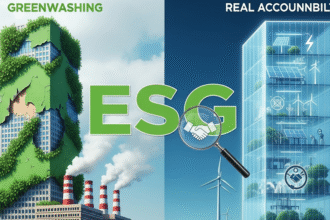The global move towards de-carbonization is accelerating and it is not only redefining domestic energy and industrial policies, but also the principles of international business. Among the most impactful new instruments to this change is one of the policy measures to provide a price on the carbon of imported goods that is similar to the amount paid by domestic producers in a carbon-pricing regime Carbon Border Adjustment Mechanism (CBAM). CBAMs are still in their infancy but are already generating a highly heated discussion concerning climate policy, fair trade and the future of globalization.
What Are Carbon Border Adjustment Mechanisms?
CBAM is actually more a tariff type of measure that is imposed on imported goods that contain carbon (steel, cement, aluminum or fertilizers). It is aimed at avoiding the leakage of carbon that happens once companies transfer their production to other nations with weaker climate policies to evade the cost of carbon. A CBAM provides the most effective method to align the domestic and foreign producers, which means that the climate policy should not compromise competition or even push the emissions out of the country. Other jurisdictions, such as the United States, Canada and Japan, are considering their own CBAM, but the European Union is already on the forefront with its own CBAM, which will be implemented between 2023 and 2026. The motivation to adopt CBAM-type measures will probably increase as more economies adopt a carbon price.
The CBAMs Reform Global Trade.
CBAMs are placed between two strong forces that are climate change mitigation and globalization. In the previous decades, the international trade system governed by the World Trade Organization (WTO) focused on cutting tariffs and non-tariffs barriers, whereas the climate policy was mostly up to the national choice. CBAMs do so by directly incorporating environmental costs into trade regulations. This has a few consequences on international trade. In the CBAM jurisdictions, exporters in countries with weak climate policies may be charged a higher price or denied access to the market which can lead to trade diversion. Meanwhile, non-CBAM nations can start implementing carbon prices in order to be not punished, which will speed up the dissemination of climate policies. But CBAMs also might lead to conflict within the WTO, where they might be viewed as disguised protectionism by the affected countries. CBAMs, in short, introduce a new dimension of competition, with carbon intensity being an equally significant factor in global supply chains, as costs or quality.
Challenges and Criticisms
CBAMs have their own drawbacks as much as they are expected to decrease carbon leakage. Computing carbon content of imports needs strong data and verification systems, which most of the countries and companies do not have which makes compliance complicated. The developing nations also claim that CBAMs may discriminate them because in most cases, they do not have the financial and technological ability to decarbonize within such a short time. It is still a controversial question whether CBAMs could be introduced without contravening the principle of non-discrimination according to the WTO General Agreement on Tariffs and Trade (GATT). Exporters might be paying the carbon costs in the country already and it is uncertain whether they will receive the funds back or not or be exempted to prevent the possibility of charging twice. Such questions point to the necessity of openness, a step-by-step process and cross-border communication.
Cleaner Production and Innovation opportunities.
Nevertheless, the controversies do not mean that cleaner production and innovation is not creating incentives by CBAMs. Exporters will have a good incentive to invest in renewable energy and low-carbon technologies and energy efficiency to keep up with the competition. The CBAM revenues may be allocated to the developing world to decarbonize it, which will be a virtuous circle. CBAMs would support global carbon pricing as a standard behavior, since internalizing the carbon price in traded goods would make it less attractive to the laggards to free-ride on the climate action of others. CBAMs have the potential to hasten the transition to a low-carbon economy worldwide and not to divide it provided that they are constructed in a fair and collaborative way.
Multilateral Coordination
To ensure that CBAMs do not turn into another front of trade wars, multilateral bodies such as the WTO, the OECD and the UNFCCC may facilitate common standards and best practices. This may involve some agreed-upon ways of quantifying embedded carbon, exceptions or transitional assistance of least-developed countries and rules of using CBAM incomes to finance climate adaptation or transfer of technology. These would assist in equalizing the principles of the common but differentiated responsibilities that drive international climate negotiations to the CBAMs.
Strategizing the Future in a multipolar world.
CBAMs could take different forms as the global economy increasingly becomes multipolar. The EU’s CBAM is only one model. Other nations may be more comfortable with gentler solutions, like labeling schemes or voluntary reporting of imports of carbon. CBAMs may be a part of larger economic partnerships because some regional trade agreements contain carbon clauses. At best, CBAMs will act as a transition to a globally harmonized price on carbon, in which trade restrictions are unnecessary since all major economies will have internalized the cost of carbon. Worse still, in a worst-case scenario, they might intensify North South rifts, trigger retaliatory tariffs and both trade and climatic stagnation.
Conclusion
Carbon Border Adjustment of carbon policy is a new approach in addressing interplay between climate policy and trade policy. CBAMs also seek to avoid any form of leakage and level playing ground to local producers by imposing a price on carbon content of imported goods. However, their effect on global trade will be determined by the way they are designed, phased in and coordinated on an international scale. The dilemma facing the policymakers is how to reconcile ambition to protect the environment and be fair, as well as ensuring a legal certainty. To companies, the word is, it is no longer optional that you know what the carbon footprint of your supply chain is and decrease it. And to the international community, CBAMs present a kind of test case of whether actions to combat climate can strengthen, but not divide the open trading system.









